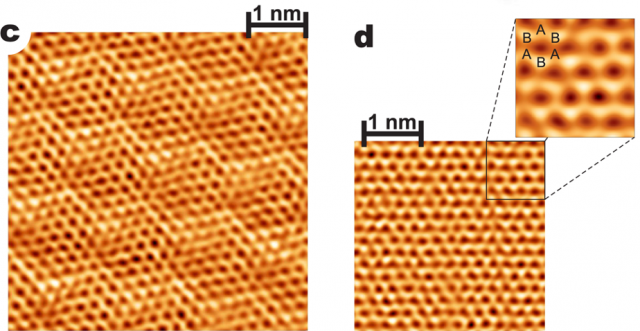How you grow graphene on d-metals key to get spin-polarized electrons
Graphene is a material with outstanding electronic characteristics. Many of them arise from the cone-like dispersion of charge carriers near the Fermi level (at which the occupation probability of energy levels is 0.5), where electrons behave as relativistic Dirac fermions, i.e., as if they had no mass. This excellent video from toutestquantique.fr summarizes them very well:
The result is an outstanding mobility that opens a lot of possibilities in spintronics, where the spin-degree of freedom is used. But there is a major problem: the electronic structure of graphene is dramatically altered if the sheet is in contact with ferromagnetic metals (permanent magnets) like iron, nickel or cobalt. Apparently this is because π-states, those for the fourth electron that is shared by each carbon atom as seen in the video, are modified by the interaction with the d-states of the metallic structure. As a consequence, they are shifted from the Fermi level.
This bad influence on the π-states of graphene has been shown to occur not only with ferromagnetic metals: it also happens with rhodium, rhenium and ruthenium, for example, which are paramagnetic but have a very active d-shell. The Dirac cone is almost undisturbed only when the substrate is very passive; this is the case with gold, copper, iridium, platinum or aluminium. If you ever wondered why gold was the substrate almost in every graphene related experiment, this is the answer.
But, what if all the problems with the ferromagnetic substrates were due just to the way the graphene sheet is grown on it? This could be the case according to the experimental results1 that a group of researchers, including Mikhail Otrokov and Evgueni Chulkov from Departamento de Fisica de Materiales-UPV/EHU, Materials Physics Center (CSIC-UPV/EHU) and DIPC, publish in Nano Letters.
For the cases of nickel and cobalt, the Dirac cone of graphene is modified in a very special way. It is split in several parts, which retain some similarities to the Dirac cone of free-standing graphene. Interestingly, theoretical considerations suggest that in spite of the strong distortions of π-states due to their hybridization with the metal d-states, a new spin-polarized cone-like interface band near the Fermi level might exist. This would offer an opportunity to obtain the desired electronic and magnetic properties combined in these composite structures.
What the researchers do in this work is, for the first time, experimentally demonstrate and theoretically support that such a Dirac cone-like feature (minicone) exists in the graphene/cobalt system and that the apex of this cone is close to the Fermi level. A system with such a property could act as a source of a spin-polarized current, a basic feature of spintronic devices.
The key aspect that gives rise to these properties is not only the materials themselves but the perfect mutual orientation of the graphene layer and the cobalt substrate, which may be achieved following the appropriate growth protocol.
The scientists explored the structural properties of a single graphene layer grown by chemical vapour deposition on a layer of cobalt [Co(0001)] and discovered that the highly ordered graphene perfectly oriented with respect to the substrate could be grown only within a certain temperature range close to that were graphene is destroyed.

The characterization using scanning tunnelling microscopy and other techniques shows a moiré pattern at 560 ºC, that corresponds to a mismatched interface; only at 660 ºC there is a perfect alignment (see Figure 1).
The researchers also found that the Dirac minicone appears in the interaction between nickel [Ni(111)] as well, but it is not as pronounced as in the one seen for cobalt. The combination of these results with band structure calculations hints to the possibility that the minicone formation could be a general feature of graphene interacting with d-metals. This potential source of spin-polarized electrons could be most important in the future development of spintronics.
Author: César Tomé López is a science writer and the editor of Mapping Ignorance.
References
- Dmitry Usachov, Alexander Fedorov, Mikhail M. Otrokov, Alla Chikina, Oleg Vilkov, Anatoly Petukhov, Artem G. Rybkin, Yury M. Koroteev, Evgueni V. Chulkov, Vera K. Adamchuk, Alexander Grüneis, Clemens Laubschat and Denis V. Vyalikh (2015) Observation of Single-Spin Dirac Fermions at the Graphene/Ferromagnet Interface Nano Letters DOI: 10.1021/nl504693u ↩